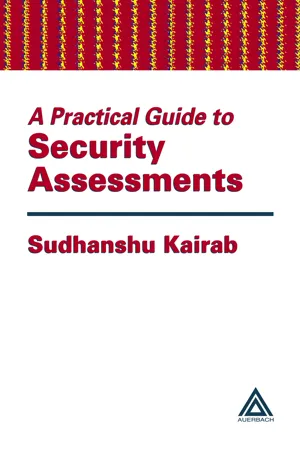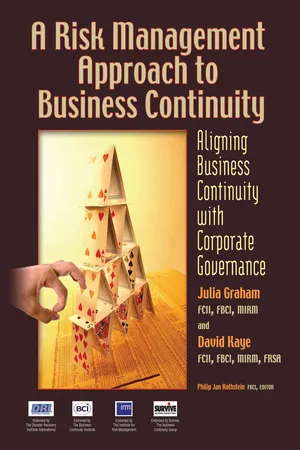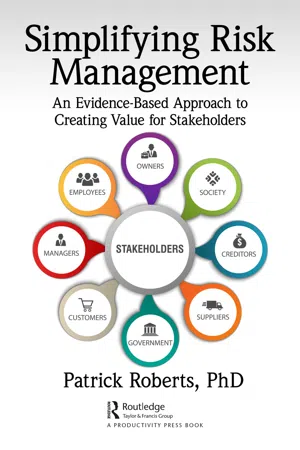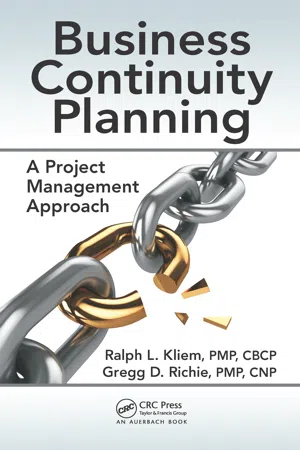Business
Business Risk Analysis
Business risk analysis involves identifying, assessing, and mitigating potential threats to a company's operations, finances, and reputation. This process helps businesses anticipate and prepare for challenges such as economic downturns, competition, regulatory changes, and natural disasters. By understanding and managing these risks, organizations can make informed decisions to protect their assets and achieve their strategic objectives.
Written by Perlego with AI-assistance
Related key terms
1 of 5
10 Key excerpts on "Business Risk Analysis"
- eBook - PDF
- Sudhanshu Kairab(Author)
- 2004(Publication Date)
- Auerbach Publications(Publisher)
Recommendations will also be developed and modified so that they are commensurate with the associated risk. Risk analysis involves taking the risks you have identified so far and expressing them in terms of what they mean to the business. It is a holistic look at the findings and involves looking at risks not just individually but also in the aggregate. One risk by itself might not be that significant, but when reviewed with other risks, it could be very important. Risk analysis also means prioritizing risks to help clients prioritize their own security initiatives and use the final report as a “security roadmap.” Doing this kind of analysis requires a good understanding of the client’s business. In particular, you should have a good understanding of what the company does, key business drivers, “mission-critical” business processes, and the critical supporting technologies — i.e., all of the things you learned in the previous phases. Although the risks have been documented to some degree in previous phases, you now need to clearly articulate risks in terms of impact to the business, as this is one of the things in which the client is most interested. In fact, this independent view of risk is probably one of the reasons you were asked to do the security assessment in the first place. If you put yourself in the client’s shoes, the first question you will have when seeing a finding is, “Why is this important?” or with clients who are more direct, you might hear the question, “So what?” The answer to these questions is the risk. The risk should clearly articulate how the finding impacts the business. The most powerful way to state risk is in terms of financial impact so to the extent that you can quantify the risk, you should do so (quantifying the risk will be discussed in more detail in the next section). Besides financial impact, there are other impacts such as damage to reputation and regulatory noncompliance, which - eBook - ePub
Certified Information Security Manager Exam Prep Guide
Gain the confidence to pass the CISM exam using test-oriented study material, 2nd Edition
- Hemang Doshi(Author)
- 2022(Publication Date)
- Packt Publishing(Publisher)
Risk identification : In this phase, significant business risks are identified. Risk identification is generally conducted by the use of risk scenarios. A risk scenario is a visualization of a possible event that could have some adverse impact on the business objectives. Organizations use risk scenarios to imagine what could go wrong or what could create barriers to achieving the business objectives.- Risk analysis : Risk analysis involves ranking risks based on their impact on business processes. The impact can be either quantifiable in monetary terms or qualitative, such as high, medium, or low risk. Both the probability of an event and its impact on the business are considered to determine the level of risk.
Risk analysis results help with the prioritization of risk responses and the allocation of resources; for example, high-risk areas are given priority for treatment.- Risk evaluation : Risk evaluation is the process of comparing the result of risk analysis against the acceptable level of risk. If the level of risk is more than the acceptable level, then risk treatment is required to bring down the risk level.
- Risk identification: The risk of the malfunction of a machine due to heavy rain.
- Risk analysis: In this phase, the level of risk is determined. Suppose that the machine costs $100,000 and the probability of heavy rain is 50%. In this case, the risk level is $50,000 (i.e., $100,000 * 50%).
- Risk evaluation: In this phase, the risk level is compared with the risk level acceptable to management. Suppose the acceptable level is only $20,000. The current risk of $50,000 exceeds the acceptable level of risk. In such a case, risk treatment is required to bring the risk level down. The organization may choose to take out insurance worth $30,000 so that the net risk remains only $20,000.
- eBook - ePub
A Risk Management Approach to Business Continuity
Aligning Business Continuity and Corporate Governance
- Julia Graham, David Kaye(Authors)
- 2015(Publication Date)
- Rothstein Publishing(Publisher)
6Introduction to the Business Impact Analysis
The Objectives Of This Chapter Are To:
• Understand the role and the values of a Business Impact Analysis (BIA) within the business continuity management process. • Understand the BIA framework, its needs, its players and its ownership • Enable a consistency and clarity of objectives • Enable a consistent, clear, and measured communication of risk issues • Access and evaluate sources of information • Consider the opportunities for decision-making around risk information evolving from the BIARisk: Definitions
A risk is the threat that an event or action will adversely affect an organisation’s ability to maximise shareholder value and to achieve business objectives. Risk arises as much from the possibility that opportunities will not be realised as it does from the possibility that threat will materialise or that mistakes will be made. A risk is integral to all opportunity and is as much about opportunity as it is about threat.This definition is in effect an enterprise-wide definition and takes in both speculative risk and operational risk; that is to say a wide definition that would embrace, for example, taking commercial decisions knowingly balancing risk and reward. Bringing opportunities for continuity planning into such a process is a useful enabler that could encourage an organisation to take a decision where they know that if the dice moved against them, they have planned an exit strategy with the aid of a reaction, or a continuity plan. While this is a real, added value of contingency planning for the board, most often the plans are developed to respond to an operational failure of some kind. Such an operational failure was defined by the Bank of International Settlements’ Basel Committee (I) as follows:“644. Operational risk is defined as the risk of loss resulting from inadequate or failed internal processes, people and systems or from external events.” - Thomas R. Peltier(Author)
- 2008(Publication Date)
- Auerbach Publications(Publisher)
1 Chapter 4 Business Impact Analysis 4.1 Overview The principal objective of the business impact analysis (BIA) is to determine the effect mission-critical information system failures have on the viability and opera-tions of enterprise core business processes. By using all of the techniques discussed in this book, you can create a facilitated process for BIA. Once the critical resources are scored, the organization can then identify appropriate controls to ensure the business continues to meet its objectives or mission. Just as we looked at scoring tables that were developed with the assistance of other departments, the BIA will work the same process. The enterprise will have to determine what elements are important and then develop a process to score those elements. The BIA will use those tables to examine the business processes and establish their priorities and what other processes are dependent on them. There are a number of tangible and intangible elements that should be consid-ered in the BIA process. In Chapter 3, we examined tables that addressed corpo-rate embarrassment, value to competitor, legal implications, cost of disruption, and financial loss. The BIA produces similar types of tables and modifies them to meet requirements of the business. Part of the BIA process comes from the risk analysis process itself. When reviewing system and application availability, the results from this process will lead the business manager to see the need for a BIA. The process will review the busi-ness areas for vulnerabilities, such items as cash flow, telecommunications systems, computer operations, or critical dependencies. 2 ◾ How to Complete a Risk Assessment in 5 Days or Less 4.2 BIA versus Risk Assessment How does risk assessment fit into the BIA process? These two processes complement one another and provide additional security from a proactive and a reactive per-spective.- No longer available |Learn more
- (Author)
- 2014(Publication Date)
- Orange Apple(Publisher)
Review and evaluation of the plan Initial risk management plans will never be perfect. Practice, experience, and actual loss results will necessitate changes in the plan and contribute information to allow possible different decisions to be made in dealing with the risks being faced. Risk analysis results and management plans should be updated periodically. There are two primary reasons for this: 1. to evaluate whether the previously selected security controls are still applicable and effective, and 2. to evaluate the possible risk level changes in the business environment. For example, information risks are a good example of rapidly changing business environment. Limitations If risks are improperly assessed and prioritized, time can be wasted in dealing with risk of losses that are not likely to occur. Spending too much time assessing and managing unlikely risks can divert resources that could be used more profitably. Unlikely events do occur but if the risk is unlikely enough to occur it may be better to simply retain the risk and deal with the result if the loss does in fact occur. Qualitative risk assessment is subjective and lacks consistency. The primary justification for a formal risk assessment process is legal and bureaucratic. ____________________ WORLD TECHNOLOGIES ____________________ Prioritizing the risk management processes too highly could keep an organization from ever completing a project or even getting started. This is especially true if other work is suspended until the risk management process is considered complete. It is also important to keep in mind the distinction between risk and uncertainty. Risk can be measured by impacts x probability. Areas of risk management As applied to corporate finance, risk management is the technique for measuring, monitoring and controlling the financial or operational risk on a firm's balance sheet. - eBook - PDF
- Thomas R. Peltier(Author)
- 2010(Publication Date)
- Auerbach Publications(Publisher)
81 Chapter 4 Business Impact Analysis 4.1 Overview The principal objective of the business impact analysis (BIA) is to determine the effect mission-critical information system failures have on the viability and opera-tions of enterprise core business processes. By using all of the techniques discussed in this book, you can create a facilitated process for BIA. Once the critical resources are scored, the organization can then identify appropriate controls to ensure the business continues to meet its objectives or mission. Just as we looked at scoring tables that were developed with the assistance of other departments, the BIA will work the same process. The enterprise will have to determine what elements are important and then develop a process to score those elements. The BIA will use those tables to examine the business processes and establish their priorities and what other processes are dependent on them. There are a number of tangible and intangible elements that should be consid-ered in the BIA process. In Chapter 3, we examined tables that addressed corpo-rate embarrassment, value to competitor, legal implications, cost of disruption, and financial loss. The BIA produces similar types of tables and modifies them to meet requirements of the business. Part of the BIA process comes from the risk analysis process itself. When reviewing system and application availability, the results from this process will lead the business manager to see the need for a BIA. The process will review the busi-ness areas for vulnerabilities, such items as cash flow, telecommunications systems, computer operations, or critical dependencies. 82 ◾ Information Security Risk Analysis 4.2 BIA versus Risk Assessment How does risk assessment fit into the BIA process? These two processes complement one another and provide additional security from a proactive and a reactive per-spective. - eBook - PDF
Simplifying Risk Management
An Evidence-Based Approach to Creating Value for Stakeholders
- Patrick Roberts(Author)
- 2022(Publication Date)
- Productivity Press(Publisher)
Risk Assessment ◾ 81 ◾ Business disruption and system failures; ◾ Execution, delivery and process management; Research into risk management in the UK NHS (Okoroh et al., 2002), identified the following categories of risk in the healthcare sector. Whilst some of these risks are indus-try-specific, others apply across sectors. ◾ Customer care; ◾ Business transfer risks; ◾ Legal risks; ◾ Facility transmitted risks; ◾ Corporate risks; ◾ Commercial risks; ◾ Financial and economic risks; Risk categorisations such as these are very useful during the risk identification process for grouping and organising risks as they emerge, be that through a formal process of anal-ysis or simply brainstorming with a group of staff. Grouping risks in a logical manner such as this then aids the search to identify additional, related risks through further analysis or more brainstorming. As mentioned above, much useful hazard information can be derived simply from talking to people, but people are often reluctant to talk about risks that may reflect badly on them-selves or their organisation. The following risk categorisation, adapted from Elliott, Swartz and Herbane (2002), is therefore highly recommended as it explicitly forces people to think about the internally generated risks (on the left-hand side) that they may feel least comfortable to highlight (Figure 5.1). However, looking ahead to risk analysis and risk treat-ment, I would emphasise once again that the most important 82 ◾ Simplifying Risk Management distinction is between value-adding and passive risks (Merton, 2005). Within the domain of passive risks, upon which we focus, it is often useful to further sub-divide these into “opera-tional” and “financial” risks. Recording and Reporting The importance of “Recording and Reporting” as part of the risk management process was highlighted in Chapter 3. Recording and reporting some key information is an integral part of the risk identification stage of the process. - eBook - PDF
Business Continuity Planning
A Project Management Approach
- Ralph L. Kliem, Gregg D. Richie(Authors)
- 2015(Publication Date)
- Auerbach Publications(Publisher)
133 7 Conduct the Business Impact Analysis With the governance infrastructure in place, the actual work of develop-ing business preparedness (BP) plans can begin. The first action is to con-duct what is known as the business impact analysis (BIA). WHAT IS A BUSINESS IMPACT ANALYSIS? The BIA is a process that requires analyzing all the operations within an organization to identify critical business processes and the impact of real-ized risks, or threats, upon them. The BIA can occur at two levels: strategic and within each critical business process. The BIA begins first at the stra-tegic level, such as among the members of the steering committee. Then, each of the critical business processes conducts a BIA, leveraging the out-put of the BIA at the strategic level. Conducting a BIA is essentially the same at both levels, with the exception of capitalizing on the output of the BIA performed at the strategic level. GOALS The BIA has several goals. Identify Critical Business Processes for the Overall Organization The guidance and direction of the steering committee can help in this regard. The committee consists of executives with responsibilities for 134 • Business Continuity Planning business processes and functions and has knowledge of strategic plans. Many members will also likely have participated in an enterprise risk management (ERM) exercise, such as those based on the use of the Committee of Sponsoring Organizations model, which provides addi-tional information and background to which ordinary employees often lack access. Additionally, many companies have also documented their processes through Lean initiatives and maturity models, thereby provid-ing important information. Identifying critical business processes can become easier by leveraging this information and experience, thereby serving as a guide for the enterprise BIA and the one for each critical business process. - No longer available |Learn more
A Manager's Guide to ISO22301
A practical guide to developing and implementing a business continuity management system
- Tony Drewitt(Author)
- 2013(Publication Date)
- ITGP(Publisher)
CHAPTER 3: BUSINESS IMPACT ANALYSIS AND RISK ASSESSMENT
These elements are really pivotal in a good BCMS. Without them, there can be no assurance that all potential interruption scenarios have been taken into account, nor that the resilience, response and recovery capabilities are comprehensive, and based on the true priorities of the organisation.Business impact analysis
The simple premise of business impact analysis (BIA) is that the BCM arrangements for each activity should be commensurate with the impact of interrupting that activity. This section looks at what BIA is for, and how to conduct it.What is BIA?
As its name suggests, BIA involves the analysis of the impacts sustained when activities are interrupted. Of course, there are many other types of impact and situations when they may be sustained, but, in the context of BCM, this is what BIA is.In order to analyse these impacts, it is necessary to understand what we are looking for. When an activity is interrupted, there is likely to be a negative impact, perhaps not immediately, but after a certain period of time. In commercial organisations, that impact might conveniently be expressed in financial terms, but, elsewhere, other ways of measuring impact may also be required.It is also usually the case that the longer the interruption continues, the greater the impact, so that each activity has a time-based impact profile. At a very basic level, it is then possible to see, and understand, the impact that would be sustained if some, or all, of an organisation’s activities were interrupted, regardless of the cause.Figure 3 illustrates a simple, impact timeline, showing the equivalent financial impact for each of five different activities, should they be interrupted, at selected points along the timeline, starting from the Business as Usual (BaU) level of zero.Figure 3: Impact profile 1This sort of data can be very useful in revealing the relative importance, or criticality, of individual activities. It can also then be used to look at the cumulative impacts, for example, if the entire organisation were to be interrupted. - eBook - ePub
Knowledge Engineering for Modern Information Systems
Methods, Models and Tools
- Anand Sharma, Sandeep Kautish, Prateek Agrawal, Vishu Madaan, Charu Gupta, Saurav Nanda, Anand Sharma, Sandeep Kautish, Prateek Agrawal, Vishu Madaan, Charu Gupta, Saurav Nanda(Authors)
- 2022(Publication Date)
- De Gruyter(Publisher)
2 ]. The main function of the management of the risk is to identify the danger and threats and accordingly manage the risk for the triumph of the project. Management of the risk provides the in-depth knowledge of the various types risk and by this project manager can estimate which type of methodology can be used to improve the efficiency of the project. For efficient allocation, the resources of the organization risk management are very crucial to know each and every aspect. By having the knowledge of the threats of the business, a project manager can also reveal stakeholders about the strength and weakness of the business.2 What is investigation of risk?
Risk inspection or analysis is defined as the series of undertaking of risk management planning, investigation of risks, and identification and controlling risk on a project for the success of enterprise.The impact of the risk event through risk analysis helps in examining how project outcomes and objectives might change. Once the risks are understand, they are analyzed to identify the qualitative and quantitative impact of the risk on the project so that appropriate steps can be taken to mitigate them. The following guidelines are used to analyze risks [3 ].Risk management is an integrated process of delineating specific areas of risk, developing a comprehensive plan, integrating the plan, and conducting the ongoing evaluation. –Dr. P.K. GuptaManaging the risk can involve taking out insurance against a loss, hedging a loan against interest-rate rises, and protecting an investment against a fall in interest rates. –Oxford Business Dictionary2.1 Why is risk management important?
For the success of any entity and business, it is very important for the business manager and owner and stakeholder to know about the dangers and threats that are affecting the business. There are several threats that hamper the business, that is, internal threat and external threat. So, for the attainment of any objective and goal, it is needed to understand each and every parameters of the risk involved in different projects and manage them effectively and efficiently.
Index pages curate the most relevant extracts from our library of academic textbooks. They’ve been created using an in-house natural language model (NLM), each adding context and meaning to key research topics.









